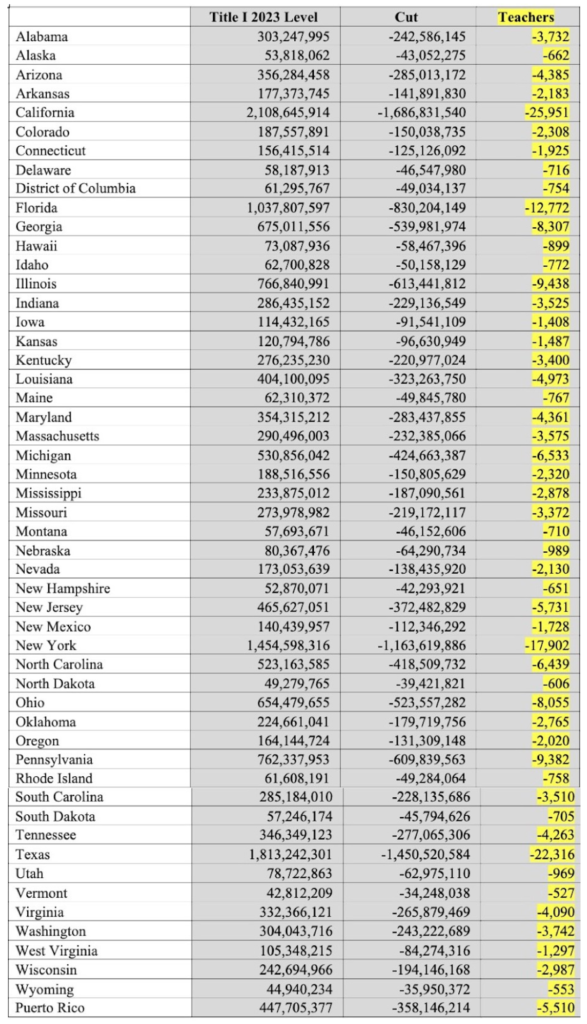Washington Update, July 17, 2023
Dear Colleagues:
On Thursday, House Republicans released their FY2024 Labor HHS Education Appropriations bill. The bill provides $67.4 billion in discretionary funding for the Department of Education- a 15% cut. However, when taking into account the additional $10 billion of existing K12 funding that was rescinded as part of the bill- the overall cut comes to $22.1 billion or a 28% decrease compared to the current FY2023 enacted levels. The bill also seeks to use policy riders as a means to block a number of Biden Administration proposals surrounding education and student debt relief. We won’t have a complete line by line breakdown until the bill goes to a full committee mark up, but as it currently stands the only seeming increase for the Department of Education goes to Charter Schools with a $10 million increase. The bill freezes funding for special education programs, Impact Aid, career technical and adult education and the maximum Pell grant at the current level of $7,395.
Key programs related to educator preparation were either eliminated or level funded as outlined in the table below:

In a press release, Appropriations Committee Ranking Member Rosa DeLauro (D-CT-03) said in part:
“When 161 House Republicans voted earlier this year to eliminate all K-12 funding at the Department of Education, I was horrified, but that was just the beginning. Now, in the midst of a teacher shortage, they have introduced a bill that would kick 220,000 teachers from classrooms. We are witnessing a widespread attack on public education that should horrify all of us…Regardless of age or stage in life, this bill means you cannot count on government for any help. It limits women’s access to abortion while stripping maternal health services and making diapers more expensive. It decimates access to preschool, education, and job training. People can only hope they do not get cancer or need mental health services—you will not find support from House Republicans. These awful cuts will make it very hard for people and should not even be considered by this committee.”
As reported in the House Democrats summary of the bill, the 28% cut to the Department of Education includes the following:
- The bill includes $3.7 billion for Title I Grants to Local Educational Agencies, a cut of $14.7 billion below the FY 2023 enacted level. This cut could force a nationwide reduction of 220,000 teachers from classrooms serving low-income students.
- The bill eliminates funding for English Language Acquisition, a cut of $890 million that would remove vital academic support for 5 million English learners nationwide.
- The bill eliminates funding for Title II-A (Supporting Effective Instruction State Grants), a cut of $2.2 billion below the enacted level.
- The bill eliminates funding for Promise Neighborhoods, a cut of $91 million below the enacted level.
- The bill eliminates funding for Social and Emotional Learning (SEL) grants within the Education Innovation and Research program, a cut of $87 million below the enacted level.
- The bill eliminates funding for Magnet Schools, a cut of $139 million below the enacted level.
- The bill includes $100 million for Full-Service Community Schools, a cut of $50 million below the enacted level.
- The bill fails to provide an increase for the maximum Pell Grant award for the first time since 2012.
- The bill eliminates funding for Federal Work Study, a cut of $1.2 billion that would eliminate work-based assistance to 660,000 students nationwide
- The bill eliminates funding for Federal Supplemental Educational Opportunity Grants, a cut of $910 million that would eliminate need-based financial aid for 1.7 million students nationwide
- The bill includes $1.8 billion for Student Aid Administration, a cut of $265 million below the enacted level.
- The bill eliminates funding for Teacher Quality Partnerships, a cut of $70 million below the enacted level.
- The bill eliminates funding for Child Care Access Means Parents in School, a cut of $75 million below the enacted level.
- The bill eliminates funding for Hawkins Centers of Excellence, a cut of $15 million below the enacted level.
- The bill eliminates funding for HBCU, TCU, and MSI Research and Development Infrastructure Grants, a cut of $50 million below the enacted level.
- The bill includes $105 million for the Office for Civil Rights, a cut of $35 million below the enacted level.
The following table breaks down what the proposed cut to Title I Funding could mean for the teaching workforce on a state by state basis:

What happens next? Since Democrats will not support this bill, and some of the Republicans from swing districts will have trouble supporting the proposed cuts to popular education programs, this bill may not ever be brought to the House floor. The Senate bill, which we are hearing could be produced as early as the last week of July, will look very different than this bill. That being said, now is not the time to sit back and hope that the Senate bill saves education funding. Your voices and advocacy opposing such drastic cuts for education funding will be critical in the coming months. Now is the time to follow up with your Members of Congress and urge them to oppose the cuts presented by the House Labor HHS Education Appropriations Subcommittee.
You can watch the Labor HHS Education Appropriations Subcommittee mark up here.
You can read the complete bill text here.
You can read the Republican Subcommittee Summary here.
You can read the Democrat’s Subcommittee Summary here.
Congress now racing towards the August recess and you can expect chock full Washington Updates for the next 2 weeks before Members head back to the home states and districts to wind down the summer.
Until next time, see you on Twitter!
Kait
@brennan_kait

